Museum of London: Stakeholder Analysis and Corporate Governance
VerifiedAdded on 2021/02/21
|11
|3210
|89
Report
AI Summary
This briefing document offers a comprehensive overview of the Museum of London, encompassing its history, strategic objectives, and efforts towards sustainability. The report delves into the museum's financial operations and corporate governance structure, providing insights into how the institution functions. A significant portion of the document is dedicated to stakeholder analysis, defining stakeholders and mapping their roles within the museum. Theories such as stakeholder salience and power grid matrix are employed to assess the levels of power and interest various stakeholders possess, along with an evaluation of current issues influencing these dynamics. The document concludes with a summary of the key findings and a review of the museum's operations and stakeholder relationships.
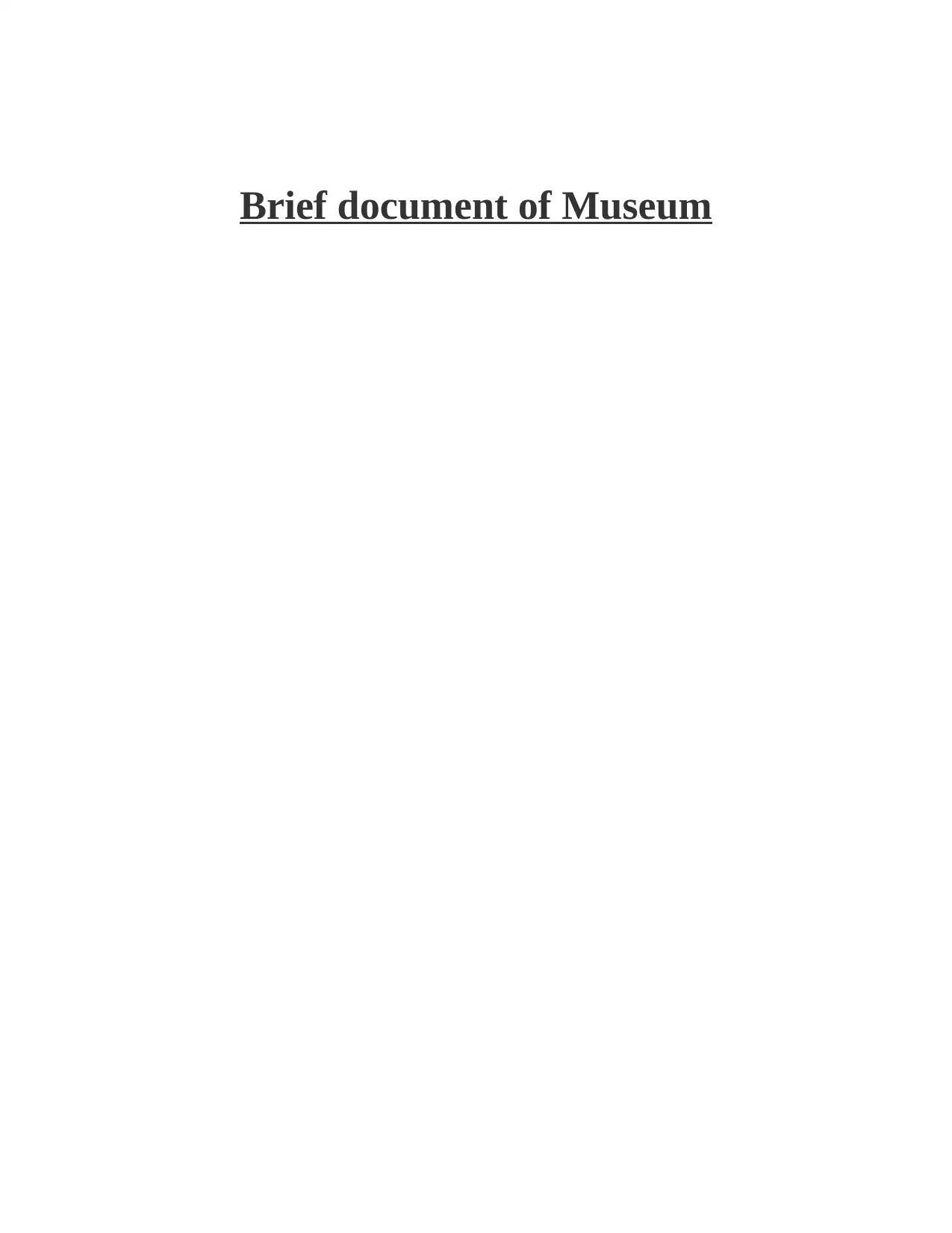
Brief document of Museum
Paraphrase This Document
Need a fresh take? Get an instant paraphrase of this document with our AI Paraphraser
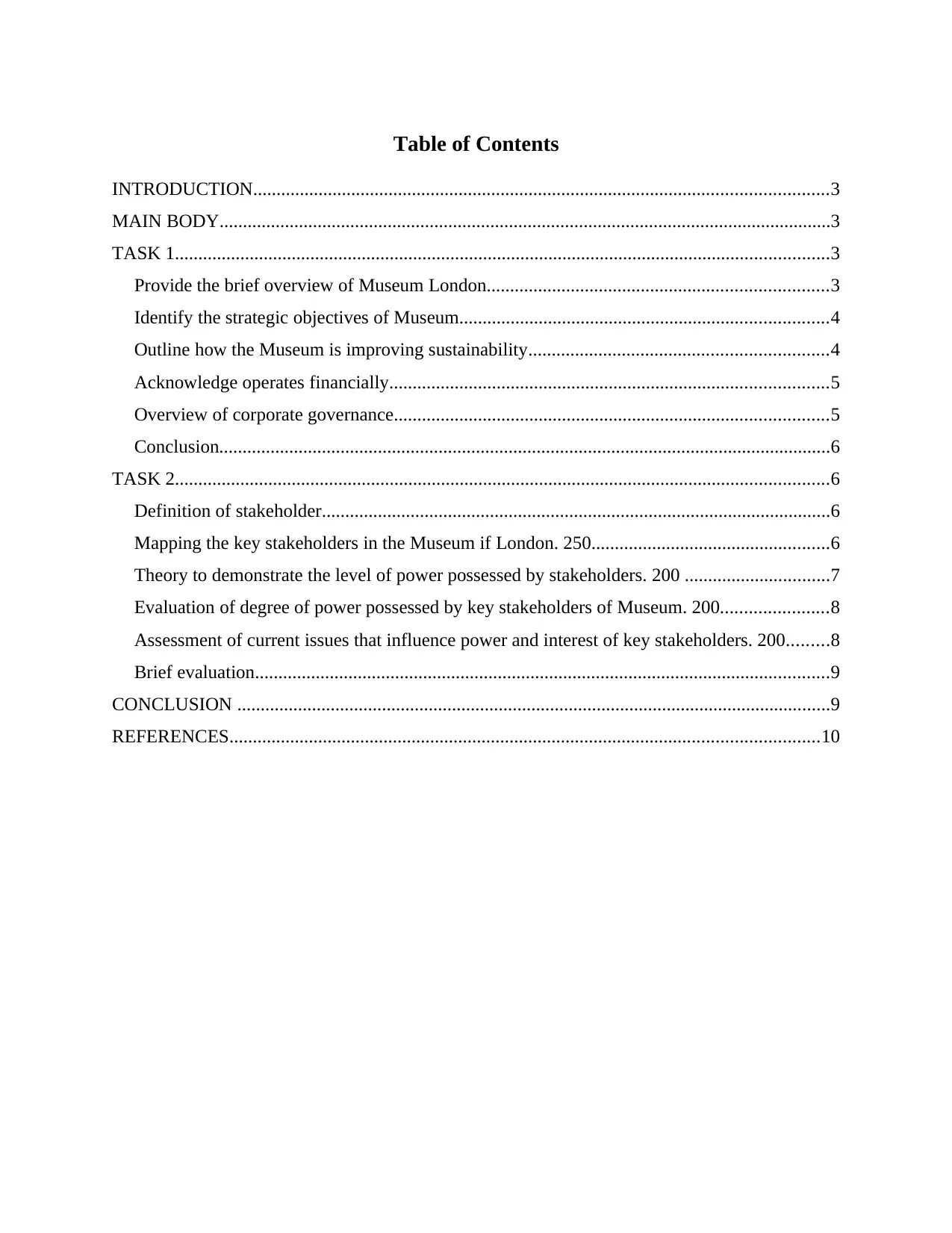
Table of Contents
INTRODUCTION...........................................................................................................................3
MAIN BODY...................................................................................................................................3
TASK 1............................................................................................................................................3
Provide the brief overview of Museum London.........................................................................3
Identify the strategic objectives of Museum...............................................................................4
Outline how the Museum is improving sustainability................................................................4
Acknowledge operates financially..............................................................................................5
Overview of corporate governance.............................................................................................5
Conclusion...................................................................................................................................6
TASK 2............................................................................................................................................6
Definition of stakeholder.............................................................................................................6
Mapping the key stakeholders in the Museum if London. 250...................................................6
Theory to demonstrate the level of power possessed by stakeholders. 200 ...............................7
Evaluation of degree of power possessed by key stakeholders of Museum. 200.......................8
Assessment of current issues that influence power and interest of key stakeholders. 200.........8
Brief evaluation...........................................................................................................................9
CONCLUSION ...............................................................................................................................9
REFERENCES..............................................................................................................................10
INTRODUCTION...........................................................................................................................3
MAIN BODY...................................................................................................................................3
TASK 1............................................................................................................................................3
Provide the brief overview of Museum London.........................................................................3
Identify the strategic objectives of Museum...............................................................................4
Outline how the Museum is improving sustainability................................................................4
Acknowledge operates financially..............................................................................................5
Overview of corporate governance.............................................................................................5
Conclusion...................................................................................................................................6
TASK 2............................................................................................................................................6
Definition of stakeholder.............................................................................................................6
Mapping the key stakeholders in the Museum if London. 250...................................................6
Theory to demonstrate the level of power possessed by stakeholders. 200 ...............................7
Evaluation of degree of power possessed by key stakeholders of Museum. 200.......................8
Assessment of current issues that influence power and interest of key stakeholders. 200.........8
Brief evaluation...........................................................................................................................9
CONCLUSION ...............................................................................................................................9
REFERENCES..............................................................................................................................10
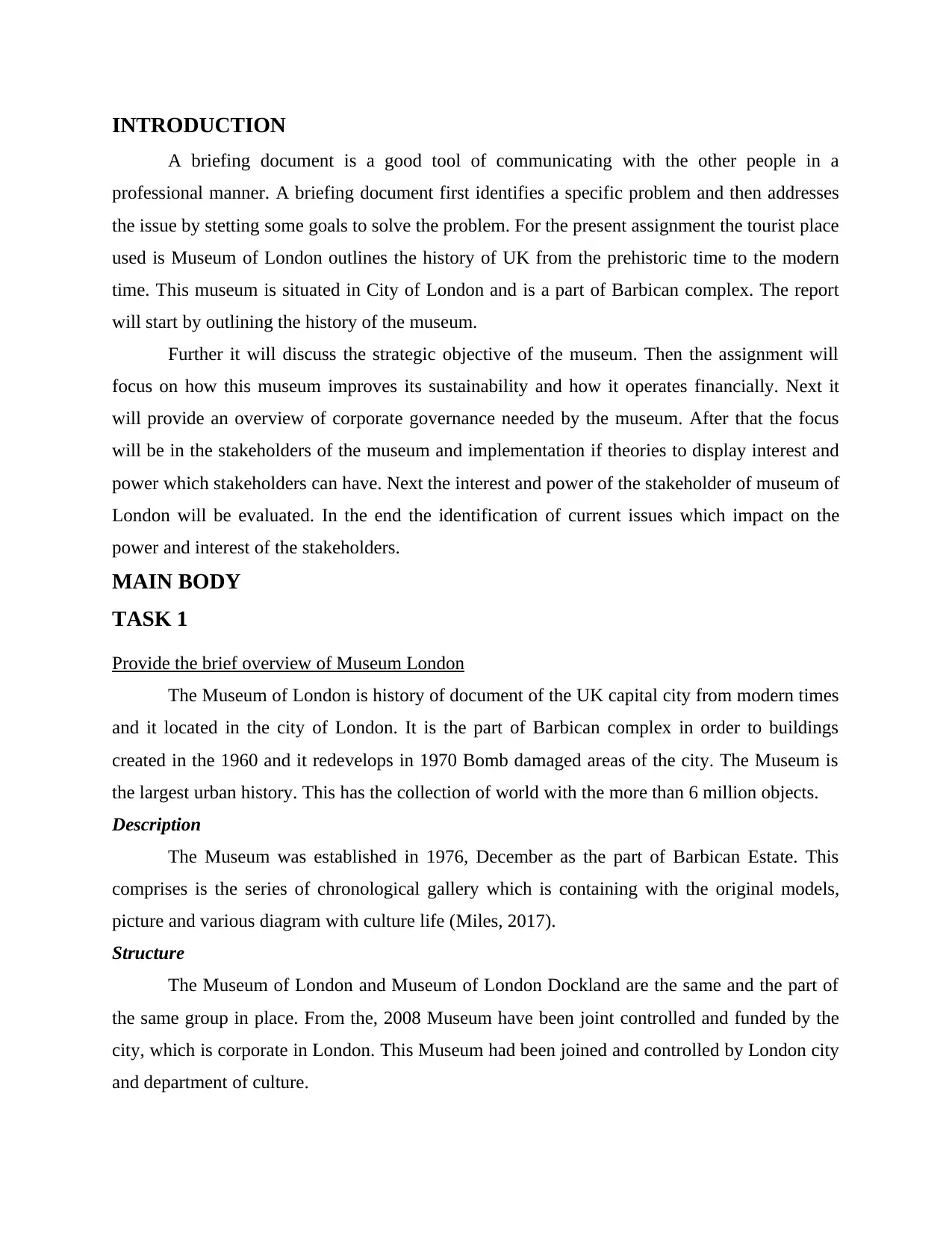
INTRODUCTION
A briefing document is a good tool of communicating with the other people in a
professional manner. A briefing document first identifies a specific problem and then addresses
the issue by stetting some goals to solve the problem. For the present assignment the tourist place
used is Museum of London outlines the history of UK from the prehistoric time to the modern
time. This museum is situated in City of London and is a part of Barbican complex. The report
will start by outlining the history of the museum.
Further it will discuss the strategic objective of the museum. Then the assignment will
focus on how this museum improves its sustainability and how it operates financially. Next it
will provide an overview of corporate governance needed by the museum. After that the focus
will be in the stakeholders of the museum and implementation if theories to display interest and
power which stakeholders can have. Next the interest and power of the stakeholder of museum of
London will be evaluated. In the end the identification of current issues which impact on the
power and interest of the stakeholders.
MAIN BODY
TASK 1
Provide the brief overview of Museum London
The Museum of London is history of document of the UK capital city from modern times
and it located in the city of London. It is the part of Barbican complex in order to buildings
created in the 1960 and it redevelops in 1970 Bomb damaged areas of the city. The Museum is
the largest urban history. This has the collection of world with the more than 6 million objects.
Description
The Museum was established in 1976, December as the part of Barbican Estate. This
comprises is the series of chronological gallery which is containing with the original models,
picture and various diagram with culture life (Miles, 2017).
Structure
The Museum of London and Museum of London Dockland are the same and the part of
the same group in place. From the, 2008 Museum have been joint controlled and funded by the
city, which is corporate in London. This Museum had been joined and controlled by London city
and department of culture.
A briefing document is a good tool of communicating with the other people in a
professional manner. A briefing document first identifies a specific problem and then addresses
the issue by stetting some goals to solve the problem. For the present assignment the tourist place
used is Museum of London outlines the history of UK from the prehistoric time to the modern
time. This museum is situated in City of London and is a part of Barbican complex. The report
will start by outlining the history of the museum.
Further it will discuss the strategic objective of the museum. Then the assignment will
focus on how this museum improves its sustainability and how it operates financially. Next it
will provide an overview of corporate governance needed by the museum. After that the focus
will be in the stakeholders of the museum and implementation if theories to display interest and
power which stakeholders can have. Next the interest and power of the stakeholder of museum of
London will be evaluated. In the end the identification of current issues which impact on the
power and interest of the stakeholders.
MAIN BODY
TASK 1
Provide the brief overview of Museum London
The Museum of London is history of document of the UK capital city from modern times
and it located in the city of London. It is the part of Barbican complex in order to buildings
created in the 1960 and it redevelops in 1970 Bomb damaged areas of the city. The Museum is
the largest urban history. This has the collection of world with the more than 6 million objects.
Description
The Museum was established in 1976, December as the part of Barbican Estate. This
comprises is the series of chronological gallery which is containing with the original models,
picture and various diagram with culture life (Miles, 2017).
Structure
The Museum of London and Museum of London Dockland are the same and the part of
the same group in place. From the, 2008 Museum have been joint controlled and funded by the
city, which is corporate in London. This Museum had been joined and controlled by London city
and department of culture.
⊘ This is a preview!⊘
Do you want full access?
Subscribe today to unlock all pages.

Trusted by 1+ million students worldwide
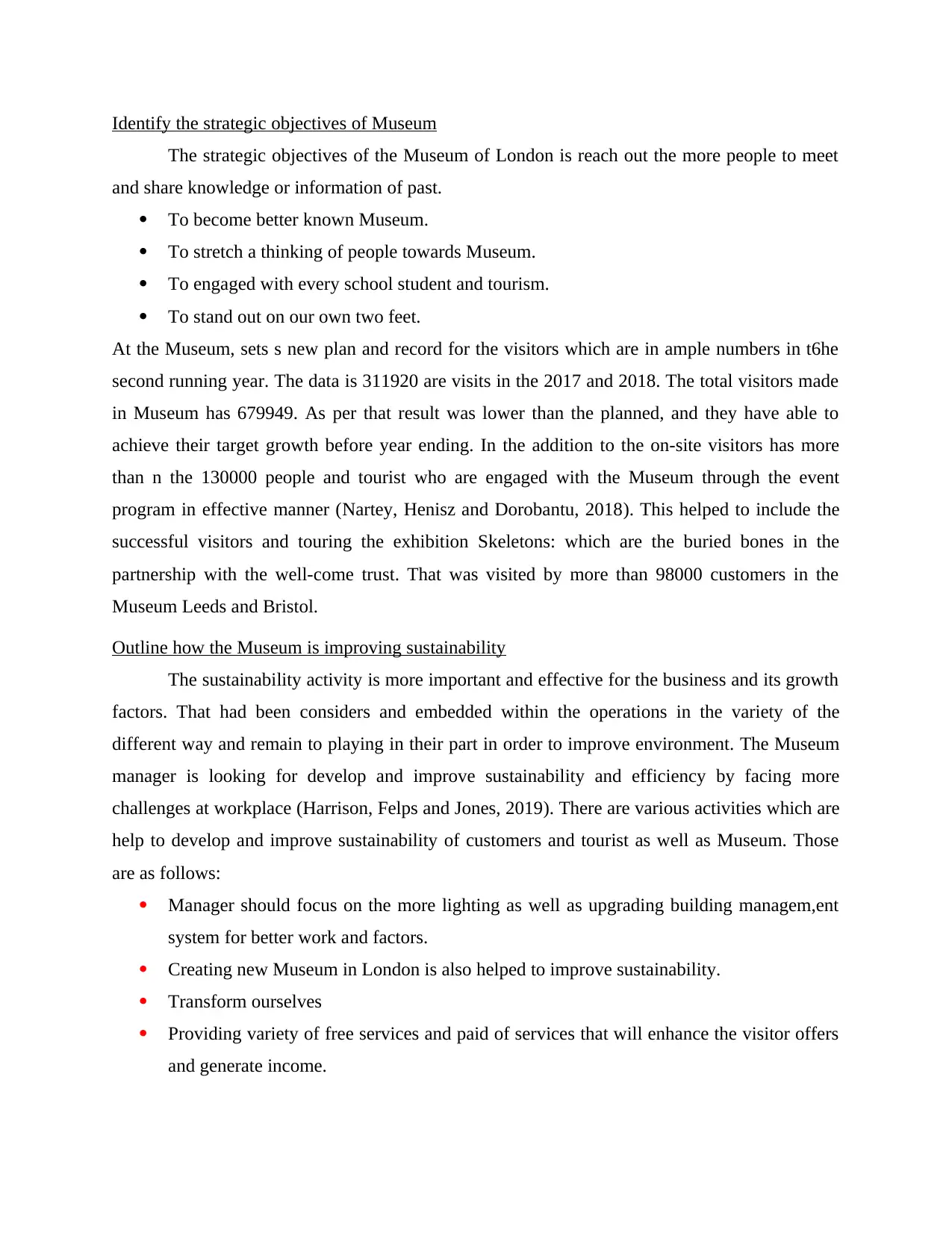
Identify the strategic objectives of Museum
The strategic objectives of the Museum of London is reach out the more people to meet
and share knowledge or information of past.
To become better known Museum.
To stretch a thinking of people towards Museum.
To engaged with every school student and tourism.
To stand out on our own two feet.
At the Museum, sets s new plan and record for the visitors which are in ample numbers in t6he
second running year. The data is 311920 are visits in the 2017 and 2018. The total visitors made
in Museum has 679949. As per that result was lower than the planned, and they have able to
achieve their target growth before year ending. In the addition to the on-site visitors has more
than n the 130000 people and tourist who are engaged with the Museum through the event
program in effective manner (Nartey, Henisz and Dorobantu, 2018). This helped to include the
successful visitors and touring the exhibition Skeletons: which are the buried bones in the
partnership with the well-come trust. That was visited by more than 98000 customers in the
Museum Leeds and Bristol.
Outline how the Museum is improving sustainability
The sustainability activity is more important and effective for the business and its growth
factors. That had been considers and embedded within the operations in the variety of the
different way and remain to playing in their part in order to improve environment. The Museum
manager is looking for develop and improve sustainability and efficiency by facing more
challenges at workplace (Harrison, Felps and Jones, 2019). There are various activities which are
help to develop and improve sustainability of customers and tourist as well as Museum. Those
are as follows:
Manager should focus on the more lighting as well as upgrading building managem,ent
system for better work and factors.
Creating new Museum in London is also helped to improve sustainability.
Transform ourselves
Providing variety of free services and paid of services that will enhance the visitor offers
and generate income.
The strategic objectives of the Museum of London is reach out the more people to meet
and share knowledge or information of past.
To become better known Museum.
To stretch a thinking of people towards Museum.
To engaged with every school student and tourism.
To stand out on our own two feet.
At the Museum, sets s new plan and record for the visitors which are in ample numbers in t6he
second running year. The data is 311920 are visits in the 2017 and 2018. The total visitors made
in Museum has 679949. As per that result was lower than the planned, and they have able to
achieve their target growth before year ending. In the addition to the on-site visitors has more
than n the 130000 people and tourist who are engaged with the Museum through the event
program in effective manner (Nartey, Henisz and Dorobantu, 2018). This helped to include the
successful visitors and touring the exhibition Skeletons: which are the buried bones in the
partnership with the well-come trust. That was visited by more than 98000 customers in the
Museum Leeds and Bristol.
Outline how the Museum is improving sustainability
The sustainability activity is more important and effective for the business and its growth
factors. That had been considers and embedded within the operations in the variety of the
different way and remain to playing in their part in order to improve environment. The Museum
manager is looking for develop and improve sustainability and efficiency by facing more
challenges at workplace (Harrison, Felps and Jones, 2019). There are various activities which are
help to develop and improve sustainability of customers and tourist as well as Museum. Those
are as follows:
Manager should focus on the more lighting as well as upgrading building managem,ent
system for better work and factors.
Creating new Museum in London is also helped to improve sustainability.
Transform ourselves
Providing variety of free services and paid of services that will enhance the visitor offers
and generate income.
Paraphrase This Document
Need a fresh take? Get an instant paraphrase of this document with our AI Paraphraser
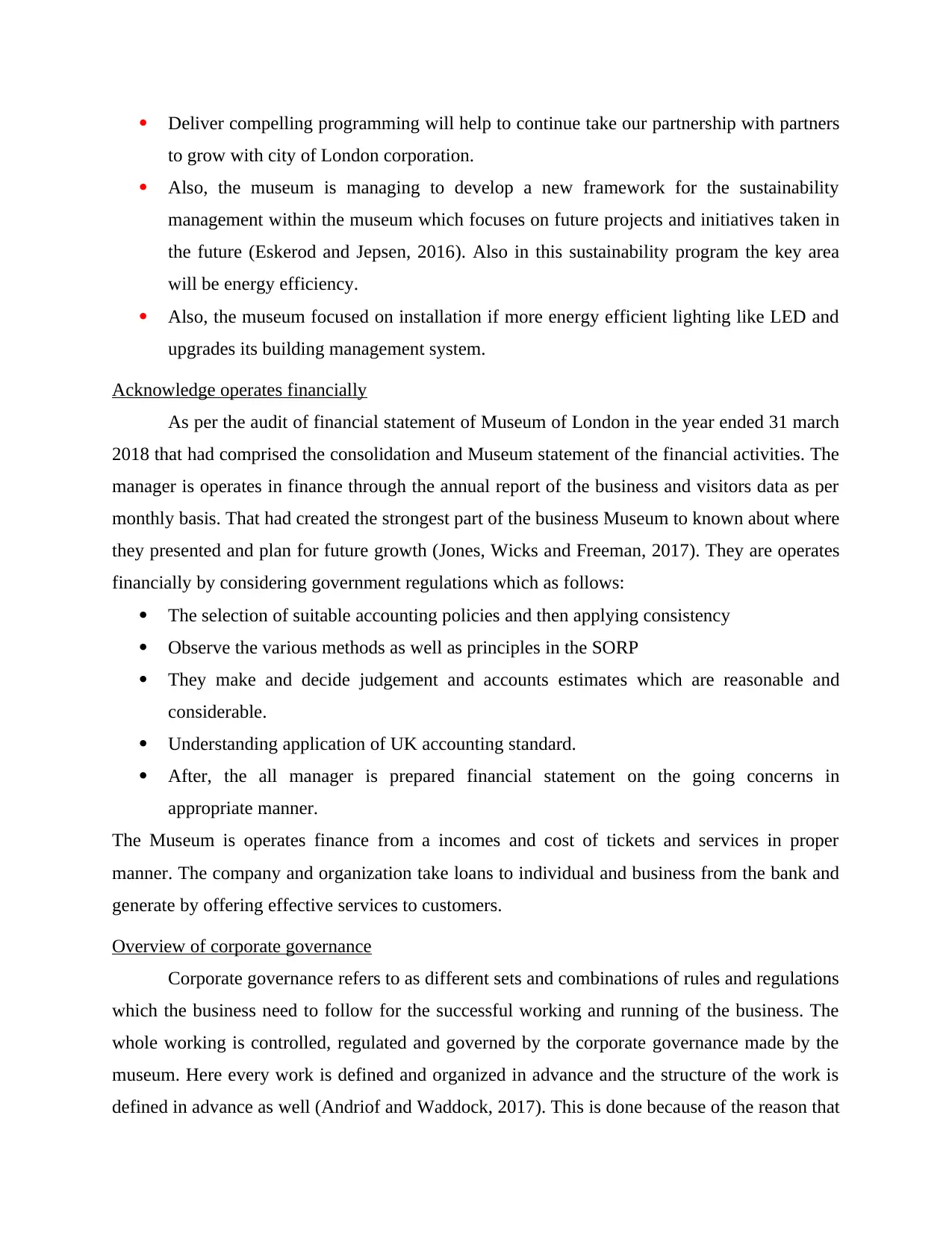
Deliver compelling programming will help to continue take our partnership with partners
to grow with city of London corporation.
Also, the museum is managing to develop a new framework for the sustainability
management within the museum which focuses on future projects and initiatives taken in
the future (Eskerod and Jepsen, 2016). Also in this sustainability program the key area
will be energy efficiency.
Also, the museum focused on installation if more energy efficient lighting like LED and
upgrades its building management system.
Acknowledge operates financially
As per the audit of financial statement of Museum of London in the year ended 31 march
2018 that had comprised the consolidation and Museum statement of the financial activities. The
manager is operates in finance through the annual report of the business and visitors data as per
monthly basis. That had created the strongest part of the business Museum to known about where
they presented and plan for future growth (Jones, Wicks and Freeman, 2017). They are operates
financially by considering government regulations which as follows:
The selection of suitable accounting policies and then applying consistency
Observe the various methods as well as principles in the SORP
They make and decide judgement and accounts estimates which are reasonable and
considerable.
Understanding application of UK accounting standard.
After, the all manager is prepared financial statement on the going concerns in
appropriate manner.
The Museum is operates finance from a incomes and cost of tickets and services in proper
manner. The company and organization take loans to individual and business from the bank and
generate by offering effective services to customers.
Overview of corporate governance
Corporate governance refers to as different sets and combinations of rules and regulations
which the business need to follow for the successful working and running of the business. The
whole working is controlled, regulated and governed by the corporate governance made by the
museum. Here every work is defined and organized in advance and the structure of the work is
defined in advance as well (Andriof and Waddock, 2017). This is done because of the reason that
to grow with city of London corporation.
Also, the museum is managing to develop a new framework for the sustainability
management within the museum which focuses on future projects and initiatives taken in
the future (Eskerod and Jepsen, 2016). Also in this sustainability program the key area
will be energy efficiency.
Also, the museum focused on installation if more energy efficient lighting like LED and
upgrades its building management system.
Acknowledge operates financially
As per the audit of financial statement of Museum of London in the year ended 31 march
2018 that had comprised the consolidation and Museum statement of the financial activities. The
manager is operates in finance through the annual report of the business and visitors data as per
monthly basis. That had created the strongest part of the business Museum to known about where
they presented and plan for future growth (Jones, Wicks and Freeman, 2017). They are operates
financially by considering government regulations which as follows:
The selection of suitable accounting policies and then applying consistency
Observe the various methods as well as principles in the SORP
They make and decide judgement and accounts estimates which are reasonable and
considerable.
Understanding application of UK accounting standard.
After, the all manager is prepared financial statement on the going concerns in
appropriate manner.
The Museum is operates finance from a incomes and cost of tickets and services in proper
manner. The company and organization take loans to individual and business from the bank and
generate by offering effective services to customers.
Overview of corporate governance
Corporate governance refers to as different sets and combinations of rules and regulations
which the business need to follow for the successful working and running of the business. The
whole working is controlled, regulated and governed by the corporate governance made by the
museum. Here every work is defined and organized in advance and the structure of the work is
defined in advance as well (Andriof and Waddock, 2017). This is done because of the reason that
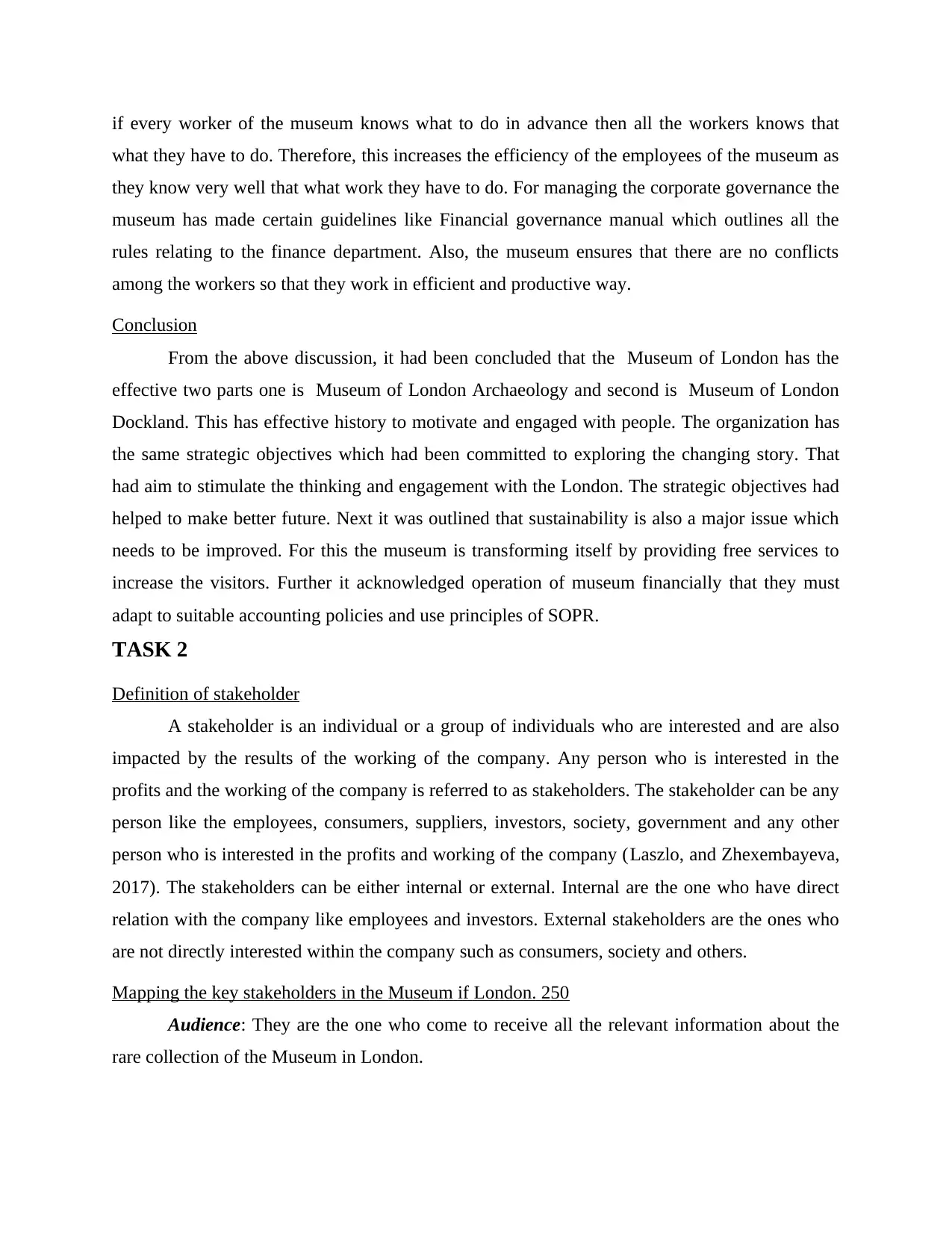
if every worker of the museum knows what to do in advance then all the workers knows that
what they have to do. Therefore, this increases the efficiency of the employees of the museum as
they know very well that what work they have to do. For managing the corporate governance the
museum has made certain guidelines like Financial governance manual which outlines all the
rules relating to the finance department. Also, the museum ensures that there are no conflicts
among the workers so that they work in efficient and productive way.
Conclusion
From the above discussion, it had been concluded that the Museum of London has the
effective two parts one is Museum of London Archaeology and second is Museum of London
Dockland. This has effective history to motivate and engaged with people. The organization has
the same strategic objectives which had been committed to exploring the changing story. That
had aim to stimulate the thinking and engagement with the London. The strategic objectives had
helped to make better future. Next it was outlined that sustainability is also a major issue which
needs to be improved. For this the museum is transforming itself by providing free services to
increase the visitors. Further it acknowledged operation of museum financially that they must
adapt to suitable accounting policies and use principles of SOPR.
TASK 2
Definition of stakeholder
A stakeholder is an individual or a group of individuals who are interested and are also
impacted by the results of the working of the company. Any person who is interested in the
profits and the working of the company is referred to as stakeholders. The stakeholder can be any
person like the employees, consumers, suppliers, investors, society, government and any other
person who is interested in the profits and working of the company (Laszlo, and Zhexembayeva,
2017). The stakeholders can be either internal or external. Internal are the one who have direct
relation with the company like employees and investors. External stakeholders are the ones who
are not directly interested within the company such as consumers, society and others.
Mapping the key stakeholders in the Museum if London. 250
Audience: They are the one who come to receive all the relevant information about the
rare collection of the Museum in London.
what they have to do. Therefore, this increases the efficiency of the employees of the museum as
they know very well that what work they have to do. For managing the corporate governance the
museum has made certain guidelines like Financial governance manual which outlines all the
rules relating to the finance department. Also, the museum ensures that there are no conflicts
among the workers so that they work in efficient and productive way.
Conclusion
From the above discussion, it had been concluded that the Museum of London has the
effective two parts one is Museum of London Archaeology and second is Museum of London
Dockland. This has effective history to motivate and engaged with people. The organization has
the same strategic objectives which had been committed to exploring the changing story. That
had aim to stimulate the thinking and engagement with the London. The strategic objectives had
helped to make better future. Next it was outlined that sustainability is also a major issue which
needs to be improved. For this the museum is transforming itself by providing free services to
increase the visitors. Further it acknowledged operation of museum financially that they must
adapt to suitable accounting policies and use principles of SOPR.
TASK 2
Definition of stakeholder
A stakeholder is an individual or a group of individuals who are interested and are also
impacted by the results of the working of the company. Any person who is interested in the
profits and the working of the company is referred to as stakeholders. The stakeholder can be any
person like the employees, consumers, suppliers, investors, society, government and any other
person who is interested in the profits and working of the company (Laszlo, and Zhexembayeva,
2017). The stakeholders can be either internal or external. Internal are the one who have direct
relation with the company like employees and investors. External stakeholders are the ones who
are not directly interested within the company such as consumers, society and others.
Mapping the key stakeholders in the Museum if London. 250
Audience: They are the one who come to receive all the relevant information about the
rare collection of the Museum in London.
⊘ This is a preview!⊘
Do you want full access?
Subscribe today to unlock all pages.

Trusted by 1+ million students worldwide
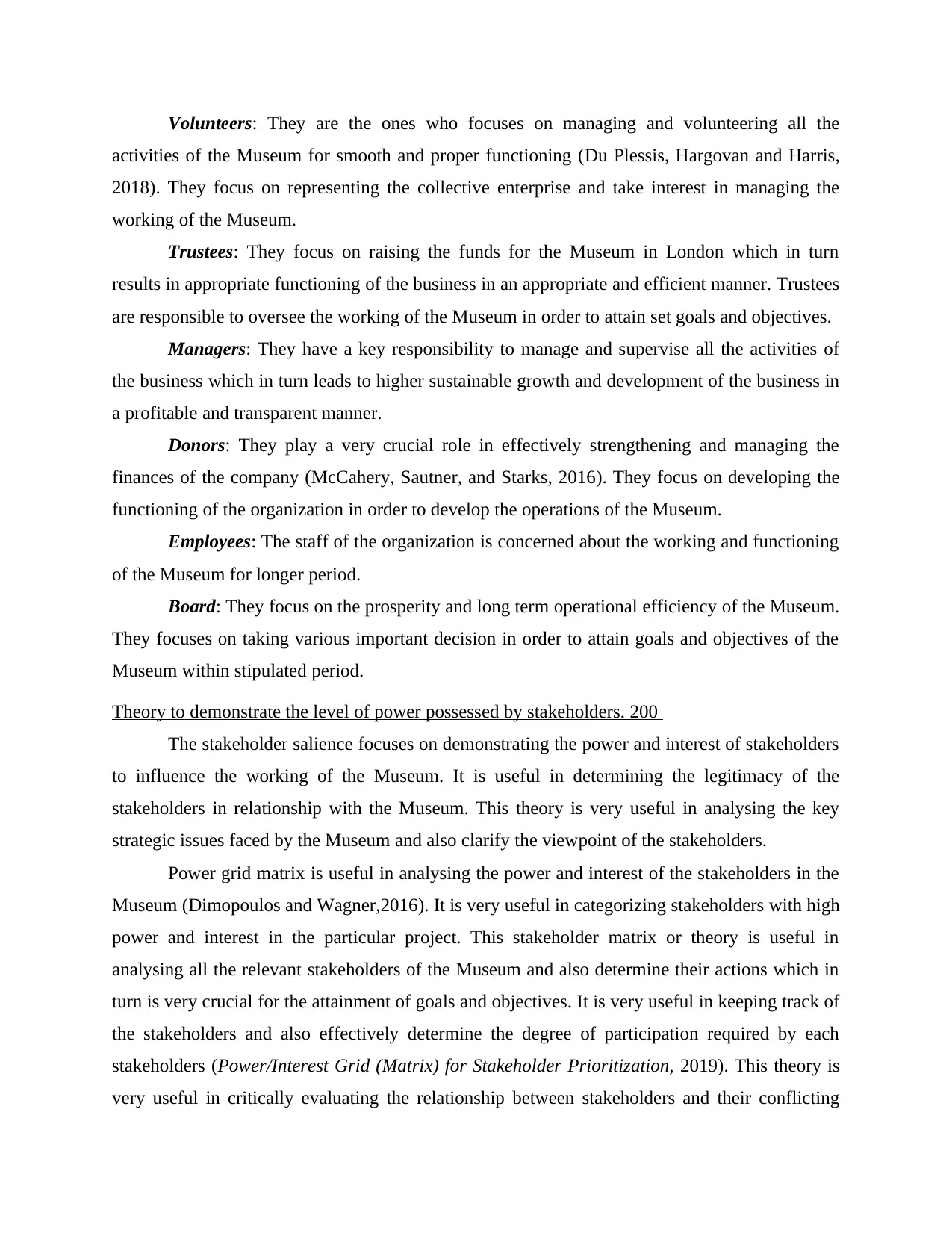
Volunteers: They are the ones who focuses on managing and volunteering all the
activities of the Museum for smooth and proper functioning (Du Plessis, Hargovan and Harris,
2018). They focus on representing the collective enterprise and take interest in managing the
working of the Museum.
Trustees: They focus on raising the funds for the Museum in London which in turn
results in appropriate functioning of the business in an appropriate and efficient manner. Trustees
are responsible to oversee the working of the Museum in order to attain set goals and objectives.
Managers: They have a key responsibility to manage and supervise all the activities of
the business which in turn leads to higher sustainable growth and development of the business in
a profitable and transparent manner.
Donors: They play a very crucial role in effectively strengthening and managing the
finances of the company (McCahery, Sautner, and Starks, 2016). They focus on developing the
functioning of the organization in order to develop the operations of the Museum.
Employees: The staff of the organization is concerned about the working and functioning
of the Museum for longer period.
Board: They focus on the prosperity and long term operational efficiency of the Museum.
They focuses on taking various important decision in order to attain goals and objectives of the
Museum within stipulated period.
Theory to demonstrate the level of power possessed by stakeholders. 200
The stakeholder salience focuses on demonstrating the power and interest of stakeholders
to influence the working of the Museum. It is useful in determining the legitimacy of the
stakeholders in relationship with the Museum. This theory is very useful in analysing the key
strategic issues faced by the Museum and also clarify the viewpoint of the stakeholders.
Power grid matrix is useful in analysing the power and interest of the stakeholders in the
Museum (Dimopoulos and Wagner,2016). It is very useful in categorizing stakeholders with high
power and interest in the particular project. This stakeholder matrix or theory is useful in
analysing all the relevant stakeholders of the Museum and also determine their actions which in
turn is very crucial for the attainment of goals and objectives. It is very useful in keeping track of
the stakeholders and also effectively determine the degree of participation required by each
stakeholders (Power/Interest Grid (Matrix) for Stakeholder Prioritization, 2019). This theory is
very useful in critically evaluating the relationship between stakeholders and their conflicting
activities of the Museum for smooth and proper functioning (Du Plessis, Hargovan and Harris,
2018). They focus on representing the collective enterprise and take interest in managing the
working of the Museum.
Trustees: They focus on raising the funds for the Museum in London which in turn
results in appropriate functioning of the business in an appropriate and efficient manner. Trustees
are responsible to oversee the working of the Museum in order to attain set goals and objectives.
Managers: They have a key responsibility to manage and supervise all the activities of
the business which in turn leads to higher sustainable growth and development of the business in
a profitable and transparent manner.
Donors: They play a very crucial role in effectively strengthening and managing the
finances of the company (McCahery, Sautner, and Starks, 2016). They focus on developing the
functioning of the organization in order to develop the operations of the Museum.
Employees: The staff of the organization is concerned about the working and functioning
of the Museum for longer period.
Board: They focus on the prosperity and long term operational efficiency of the Museum.
They focuses on taking various important decision in order to attain goals and objectives of the
Museum within stipulated period.
Theory to demonstrate the level of power possessed by stakeholders. 200
The stakeholder salience focuses on demonstrating the power and interest of stakeholders
to influence the working of the Museum. It is useful in determining the legitimacy of the
stakeholders in relationship with the Museum. This theory is very useful in analysing the key
strategic issues faced by the Museum and also clarify the viewpoint of the stakeholders.
Power grid matrix is useful in analysing the power and interest of the stakeholders in the
Museum (Dimopoulos and Wagner,2016). It is very useful in categorizing stakeholders with high
power and interest in the particular project. This stakeholder matrix or theory is useful in
analysing all the relevant stakeholders of the Museum and also determine their actions which in
turn is very crucial for the attainment of goals and objectives. It is very useful in keeping track of
the stakeholders and also effectively determine the degree of participation required by each
stakeholders (Power/Interest Grid (Matrix) for Stakeholder Prioritization, 2019). This theory is
very useful in critically evaluating the relationship between stakeholders and their conflicting
Paraphrase This Document
Need a fresh take? Get an instant paraphrase of this document with our AI Paraphraser
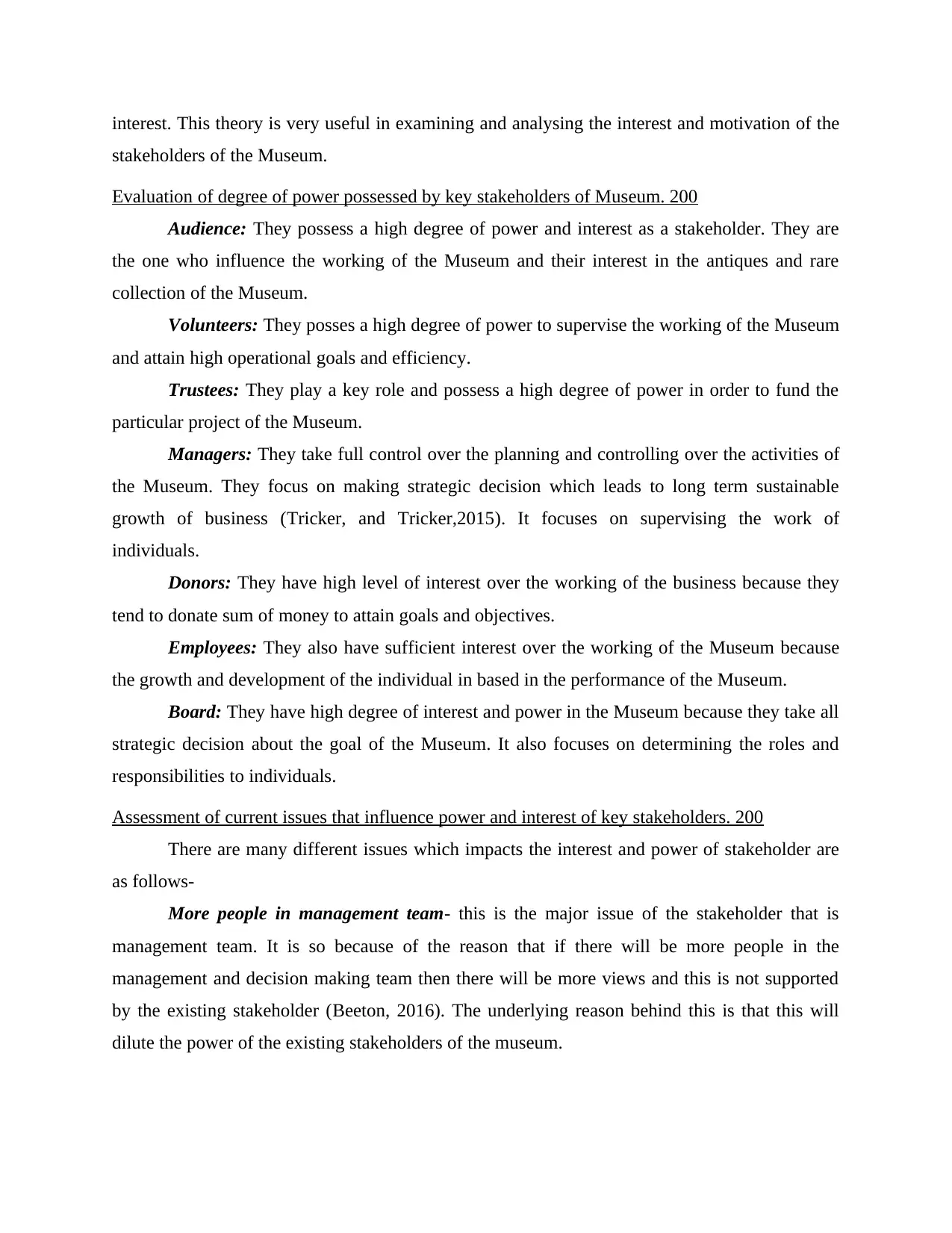
interest. This theory is very useful in examining and analysing the interest and motivation of the
stakeholders of the Museum.
Evaluation of degree of power possessed by key stakeholders of Museum. 200
Audience: They possess a high degree of power and interest as a stakeholder. They are
the one who influence the working of the Museum and their interest in the antiques and rare
collection of the Museum.
Volunteers: They posses a high degree of power to supervise the working of the Museum
and attain high operational goals and efficiency.
Trustees: They play a key role and possess a high degree of power in order to fund the
particular project of the Museum.
Managers: They take full control over the planning and controlling over the activities of
the Museum. They focus on making strategic decision which leads to long term sustainable
growth of business (Tricker, and Tricker,2015). It focuses on supervising the work of
individuals.
Donors: They have high level of interest over the working of the business because they
tend to donate sum of money to attain goals and objectives.
Employees: They also have sufficient interest over the working of the Museum because
the growth and development of the individual in based in the performance of the Museum.
Board: They have high degree of interest and power in the Museum because they take all
strategic decision about the goal of the Museum. It also focuses on determining the roles and
responsibilities to individuals.
Assessment of current issues that influence power and interest of key stakeholders. 200
There are many different issues which impacts the interest and power of stakeholder are
as follows-
More people in management team- this is the major issue of the stakeholder that is
management team. It is so because of the reason that if there will be more people in the
management and decision making team then there will be more views and this is not supported
by the existing stakeholder (Beeton, 2016). The underlying reason behind this is that this will
dilute the power of the existing stakeholders of the museum.
stakeholders of the Museum.
Evaluation of degree of power possessed by key stakeholders of Museum. 200
Audience: They possess a high degree of power and interest as a stakeholder. They are
the one who influence the working of the Museum and their interest in the antiques and rare
collection of the Museum.
Volunteers: They posses a high degree of power to supervise the working of the Museum
and attain high operational goals and efficiency.
Trustees: They play a key role and possess a high degree of power in order to fund the
particular project of the Museum.
Managers: They take full control over the planning and controlling over the activities of
the Museum. They focus on making strategic decision which leads to long term sustainable
growth of business (Tricker, and Tricker,2015). It focuses on supervising the work of
individuals.
Donors: They have high level of interest over the working of the business because they
tend to donate sum of money to attain goals and objectives.
Employees: They also have sufficient interest over the working of the Museum because
the growth and development of the individual in based in the performance of the Museum.
Board: They have high degree of interest and power in the Museum because they take all
strategic decision about the goal of the Museum. It also focuses on determining the roles and
responsibilities to individuals.
Assessment of current issues that influence power and interest of key stakeholders. 200
There are many different issues which impacts the interest and power of stakeholder are
as follows-
More people in management team- this is the major issue of the stakeholder that is
management team. It is so because of the reason that if there will be more people in the
management and decision making team then there will be more views and this is not supported
by the existing stakeholder (Beeton, 2016). The underlying reason behind this is that this will
dilute the power of the existing stakeholders of the museum.
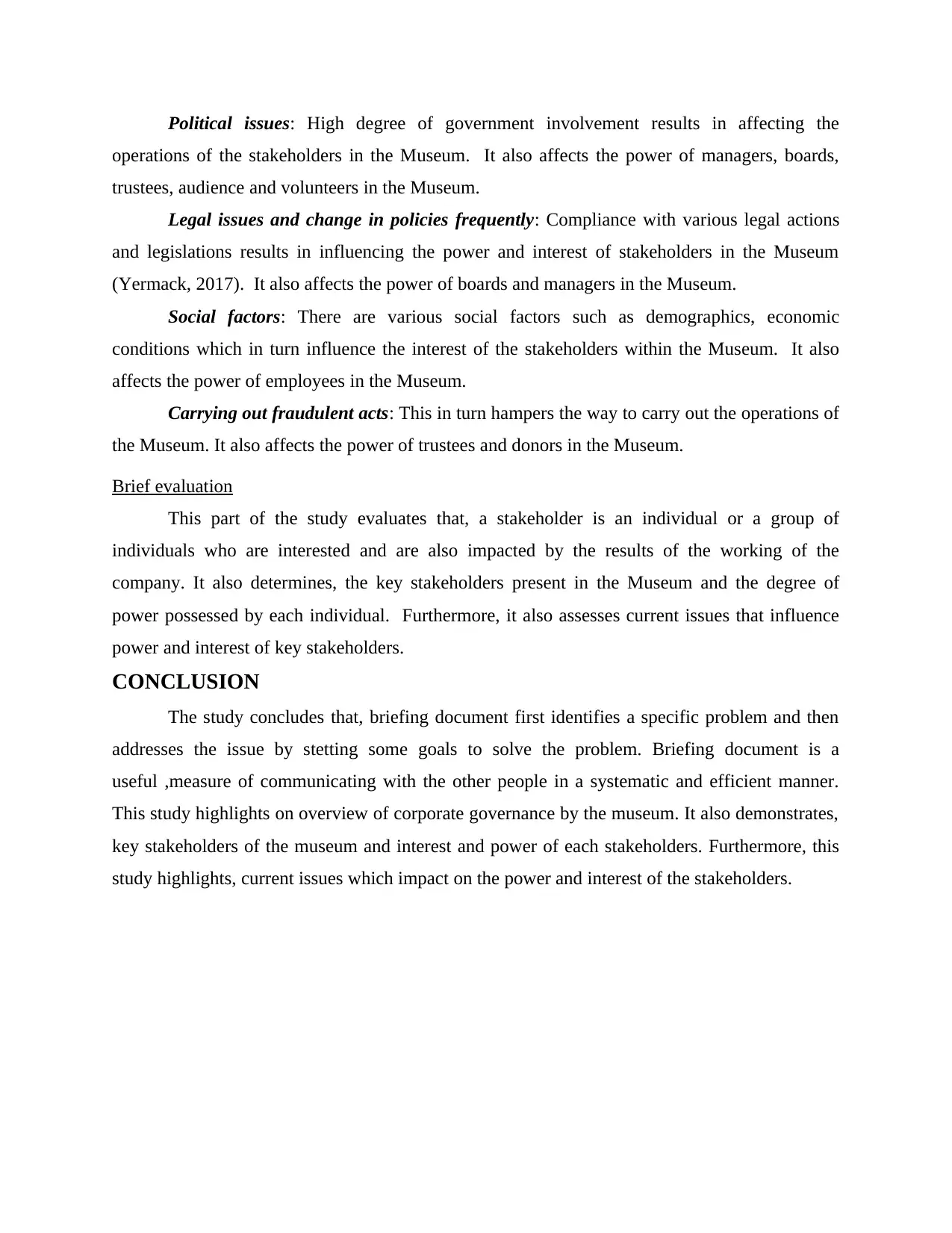
Political issues: High degree of government involvement results in affecting the
operations of the stakeholders in the Museum. It also affects the power of managers, boards,
trustees, audience and volunteers in the Museum.
Legal issues and change in policies frequently: Compliance with various legal actions
and legislations results in influencing the power and interest of stakeholders in the Museum
(Yermack, 2017). It also affects the power of boards and managers in the Museum.
Social factors: There are various social factors such as demographics, economic
conditions which in turn influence the interest of the stakeholders within the Museum. It also
affects the power of employees in the Museum.
Carrying out fraudulent acts: This in turn hampers the way to carry out the operations of
the Museum. It also affects the power of trustees and donors in the Museum.
Brief evaluation
This part of the study evaluates that, a stakeholder is an individual or a group of
individuals who are interested and are also impacted by the results of the working of the
company. It also determines, the key stakeholders present in the Museum and the degree of
power possessed by each individual. Furthermore, it also assesses current issues that influence
power and interest of key stakeholders.
CONCLUSION
The study concludes that, briefing document first identifies a specific problem and then
addresses the issue by stetting some goals to solve the problem. Briefing document is a
useful ,measure of communicating with the other people in a systematic and efficient manner.
This study highlights on overview of corporate governance by the museum. It also demonstrates,
key stakeholders of the museum and interest and power of each stakeholders. Furthermore, this
study highlights, current issues which impact on the power and interest of the stakeholders.
operations of the stakeholders in the Museum. It also affects the power of managers, boards,
trustees, audience and volunteers in the Museum.
Legal issues and change in policies frequently: Compliance with various legal actions
and legislations results in influencing the power and interest of stakeholders in the Museum
(Yermack, 2017). It also affects the power of boards and managers in the Museum.
Social factors: There are various social factors such as demographics, economic
conditions which in turn influence the interest of the stakeholders within the Museum. It also
affects the power of employees in the Museum.
Carrying out fraudulent acts: This in turn hampers the way to carry out the operations of
the Museum. It also affects the power of trustees and donors in the Museum.
Brief evaluation
This part of the study evaluates that, a stakeholder is an individual or a group of
individuals who are interested and are also impacted by the results of the working of the
company. It also determines, the key stakeholders present in the Museum and the degree of
power possessed by each individual. Furthermore, it also assesses current issues that influence
power and interest of key stakeholders.
CONCLUSION
The study concludes that, briefing document first identifies a specific problem and then
addresses the issue by stetting some goals to solve the problem. Briefing document is a
useful ,measure of communicating with the other people in a systematic and efficient manner.
This study highlights on overview of corporate governance by the museum. It also demonstrates,
key stakeholders of the museum and interest and power of each stakeholders. Furthermore, this
study highlights, current issues which impact on the power and interest of the stakeholders.
⊘ This is a preview!⊘
Do you want full access?
Subscribe today to unlock all pages.

Trusted by 1+ million students worldwide
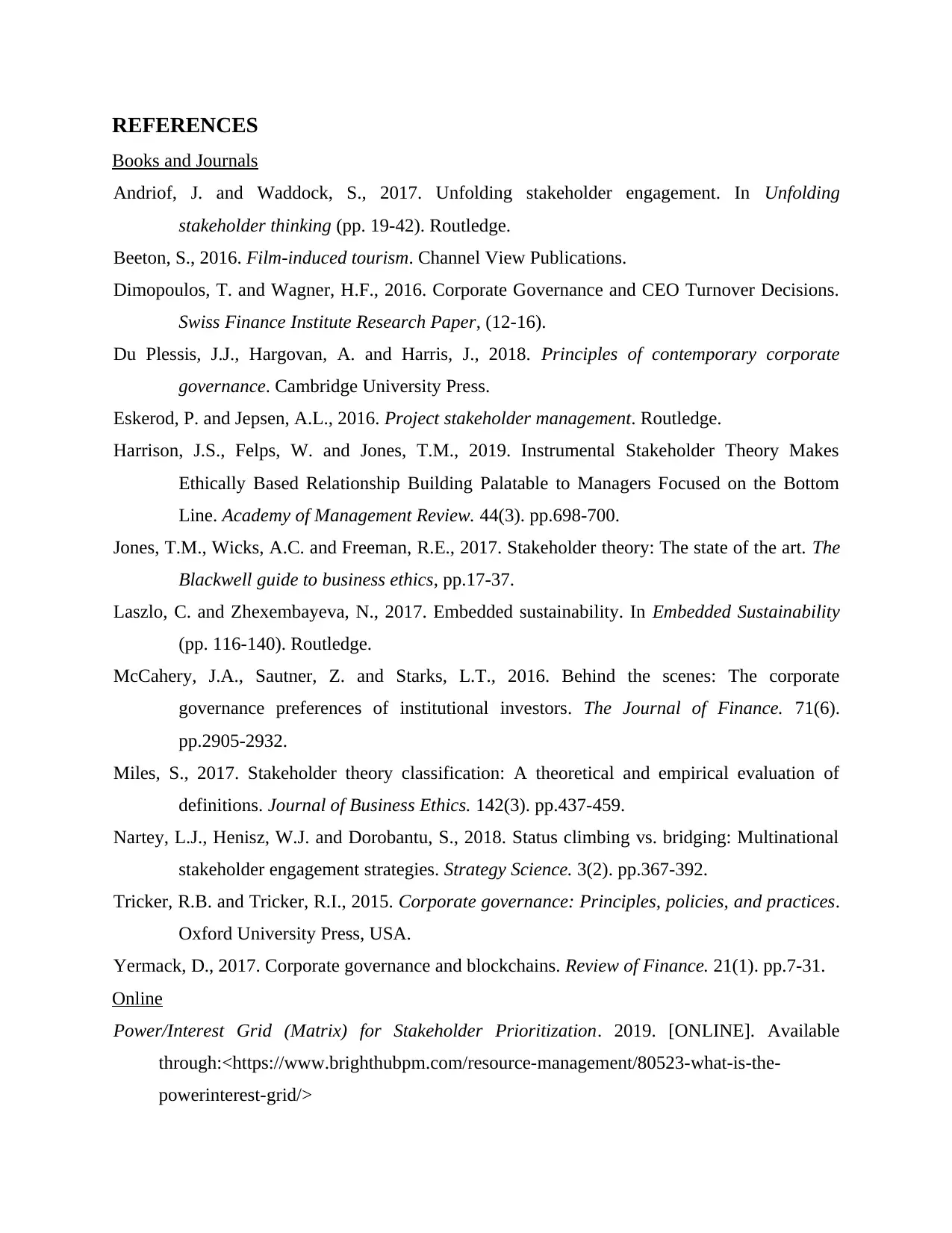
REFERENCES
Books and Journals
Andriof, J. and Waddock, S., 2017. Unfolding stakeholder engagement. In Unfolding
stakeholder thinking (pp. 19-42). Routledge.
Beeton, S., 2016. Film-induced tourism. Channel View Publications.
Dimopoulos, T. and Wagner, H.F., 2016. Corporate Governance and CEO Turnover Decisions.
Swiss Finance Institute Research Paper, (12-16).
Du Plessis, J.J., Hargovan, A. and Harris, J., 2018. Principles of contemporary corporate
governance. Cambridge University Press.
Eskerod, P. and Jepsen, A.L., 2016. Project stakeholder management. Routledge.
Harrison, J.S., Felps, W. and Jones, T.M., 2019. Instrumental Stakeholder Theory Makes
Ethically Based Relationship Building Palatable to Managers Focused on the Bottom
Line. Academy of Management Review. 44(3). pp.698-700.
Jones, T.M., Wicks, A.C. and Freeman, R.E., 2017. Stakeholder theory: The state of the art. The
Blackwell guide to business ethics, pp.17-37.
Laszlo, C. and Zhexembayeva, N., 2017. Embedded sustainability. In Embedded Sustainability
(pp. 116-140). Routledge.
McCahery, J.A., Sautner, Z. and Starks, L.T., 2016. Behind the scenes: The corporate
governance preferences of institutional investors. The Journal of Finance. 71(6).
pp.2905-2932.
Miles, S., 2017. Stakeholder theory classification: A theoretical and empirical evaluation of
definitions. Journal of Business Ethics. 142(3). pp.437-459.
Nartey, L.J., Henisz, W.J. and Dorobantu, S., 2018. Status climbing vs. bridging: Multinational
stakeholder engagement strategies. Strategy Science. 3(2). pp.367-392.
Tricker, R.B. and Tricker, R.I., 2015. Corporate governance: Principles, policies, and practices.
Oxford University Press, USA.
Yermack, D., 2017. Corporate governance and blockchains. Review of Finance. 21(1). pp.7-31.
Online
Power/Interest Grid (Matrix) for Stakeholder Prioritization. 2019. [ONLINE]. Available
through:<https://www.brighthubpm.com/resource-management/80523-what-is-the-
powerinterest-grid/>
Books and Journals
Andriof, J. and Waddock, S., 2017. Unfolding stakeholder engagement. In Unfolding
stakeholder thinking (pp. 19-42). Routledge.
Beeton, S., 2016. Film-induced tourism. Channel View Publications.
Dimopoulos, T. and Wagner, H.F., 2016. Corporate Governance and CEO Turnover Decisions.
Swiss Finance Institute Research Paper, (12-16).
Du Plessis, J.J., Hargovan, A. and Harris, J., 2018. Principles of contemporary corporate
governance. Cambridge University Press.
Eskerod, P. and Jepsen, A.L., 2016. Project stakeholder management. Routledge.
Harrison, J.S., Felps, W. and Jones, T.M., 2019. Instrumental Stakeholder Theory Makes
Ethically Based Relationship Building Palatable to Managers Focused on the Bottom
Line. Academy of Management Review. 44(3). pp.698-700.
Jones, T.M., Wicks, A.C. and Freeman, R.E., 2017. Stakeholder theory: The state of the art. The
Blackwell guide to business ethics, pp.17-37.
Laszlo, C. and Zhexembayeva, N., 2017. Embedded sustainability. In Embedded Sustainability
(pp. 116-140). Routledge.
McCahery, J.A., Sautner, Z. and Starks, L.T., 2016. Behind the scenes: The corporate
governance preferences of institutional investors. The Journal of Finance. 71(6).
pp.2905-2932.
Miles, S., 2017. Stakeholder theory classification: A theoretical and empirical evaluation of
definitions. Journal of Business Ethics. 142(3). pp.437-459.
Nartey, L.J., Henisz, W.J. and Dorobantu, S., 2018. Status climbing vs. bridging: Multinational
stakeholder engagement strategies. Strategy Science. 3(2). pp.367-392.
Tricker, R.B. and Tricker, R.I., 2015. Corporate governance: Principles, policies, and practices.
Oxford University Press, USA.
Yermack, D., 2017. Corporate governance and blockchains. Review of Finance. 21(1). pp.7-31.
Online
Power/Interest Grid (Matrix) for Stakeholder Prioritization. 2019. [ONLINE]. Available
through:<https://www.brighthubpm.com/resource-management/80523-what-is-the-
powerinterest-grid/>
Paraphrase This Document
Need a fresh take? Get an instant paraphrase of this document with our AI Paraphraser

1 out of 11
Related Documents
Your All-in-One AI-Powered Toolkit for Academic Success.
+13062052269
info@desklib.com
Available 24*7 on WhatsApp / Email
![[object Object]](/_next/static/media/star-bottom.7253800d.svg)
Unlock your academic potential
Copyright © 2020–2025 A2Z Services. All Rights Reserved. Developed and managed by ZUCOL.





